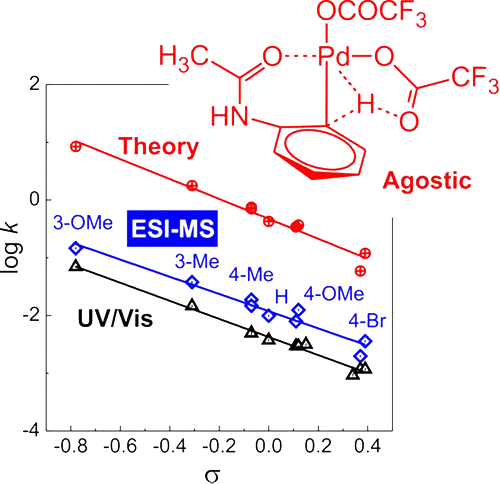Palladium-Catalyzed C–H Activation: Mass Spectrometric Approach to Reaction Kinetics in Solution, Jiří Váňa, Thibault Terencio, Vladimir Petrović, Orsolya Tischler, Zoltán Novák, Jana Roithová, Organometallics 2017, 36, 2072-2080. DOI: 10.1021/acs.organomet.6b00960 | [Full Text Link] [Supp. Info. Link, XYZ]
We report a new method for determination of rate constants of processes in solution using electrospray ionization mass spectrometry (ESI-MS). The investigated reaction is C–H activation of acetanilides by palladium(II)trifluoroacetate leading to stable organopalladium complexes. The rate constants can be determined from an experiment with a couple of differently substituted acetanilides being in competition for being activated by the palladium salt. The formed organopalladium complexes can be detected by ESI-MS. The time dependence is achieved by adding one of the acetanilides to the reaction mixture with a time delay. The kinetics can be then evaluated from the evolution of the ratio of the ESI-MS signals of differently substituted complexes as a function of the time delay. The Hammett analysis of the rate constants obtained for a series of meta- and para-substituted acetanilides provides a ρ value of −1.5, which is in agreement with values reported for similar C–H activations. We have also investigated the very same reaction with UV–vis spectroscopy that gave us about three times smaller rate constants but the same trend with the ρ value of −1.6. The rate constants determined by ESI-MS are directly linked to the occurrence of organopalladium complexes, whereas the UV–vis data are associated with an absorption spectra change that could involve more reaction steps. DFT calculations support the interpretation of the reaction mechanism as cyclopalladation and provide the ρ value in the same range. The rate-determining step corresponds to the agostic C–H transition structure.

